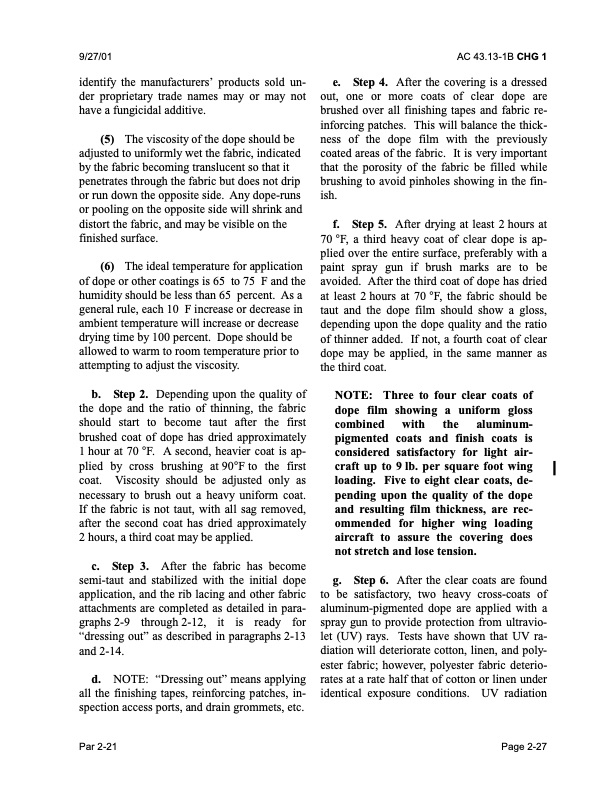
PDF Publication Title:
Text from PDF Page: 104
9/27/01 AC 43.13-1B CHG 1 identify the manufacturers’ products sold un der proprietary trade names may or may not have a fungicidal additive. (5) The viscosity of the dope should be adjusted to uniformly wet the fabric, indicated by the fabric becoming translucent so that it penetrates through the fabric but does not drip or run down the opposite side. Any dope-runs or pooling on the opposite side will shrink and distort the fabric, and may be visible on the finished surface. (6) The ideal temperature for application of dope or other coatings is 65 to 75 F and the humidity should be less than 65 percent. As a general rule, each 10 F increase or decrease in ambient temperature will increase or decrease drying time by 100 percent. Dope should be allowed to warm to room temperature prior to attempting to adjust the viscosity. b. Step 2. Depending upon the quality of the dope and the ratio of thinning, the fabric should start to become taut after the first brushed coat of dope has dried approximately 1 hour at 70 °F. A second, heavier coat is ap plied by cross brushing at 90°F=to the first coat. Viscosity should be adjusted only as necessary to brush out a heavy uniform coat. If the fabric is not taut, with all sag removed, after the second coat has dried approximately 2 hours, a third coat may be applied. c. Step 3. After the fabric has become semi-taut and stabilized with the initial dope application, and the rib lacing and other fabric attachments are completed as detailed in para graphs 2-9 through 2-12, it is ready for “dressing out” as described in paragraphs 2-13 and 2-14. d. NOTE: “Dressing out” means applying all the finishing tapes, reinforcing patches, in spection access ports, and drain grommets, etc. e. Step 4. After the covering is a dressed out, one or more coats of clear dope are brushed over all finishing tapes and fabric re inforcing patches. This will balance the thick ness of the dope film with the previously coated areas of the fabric. It is very important that the porosity of the fabric be filled while brushing to avoid pinholes showing in the fin ish. f. Step 5. After drying at least 2 hours at 70 °F, a third heavy coat of clear dope is ap plied over the entire surface, preferably with a paint spray gun if brush marks are to be avoided. After the third coat of dope has dried at least 2 hours at 70 °F, the fabric should be taut and the dope film should show a gloss, depending upon the dope quality and the ratio of thinner added. If not, a fourth coat of clear dope may be applied, in the same manner as the third coat. NOTE: Three to four clear coats of dope film showing a uniform gloss combined with the aluminum- pigmented coats and finish coats is considered satisfactory for light air- craft up to 9 lb. per square foot wing loading. Five to eight clear coats, de- pending upon the quality of the dope and resulting film thickness, are rec- ommended for higher wing loading aircraft to assure the covering does not stretch and lose tension. g. Step 6. After the clear coats are found to be satisfactory, two heavy cross-coats of aluminum-pigmented dope are applied with a spray gun to provide protection from ultravio let (UV) rays. Tests have shown that UV ra diation will deteriorate cotton, linen, and poly ester fabric; however, polyester fabric deterio rates at a rate half that of cotton or linen under identical exposure conditions. UV radiation Par 2-21 Page 2-27PDF Image | AFS-640

PDF Search Title:
AFS-640Original File Name Searched:
ac_43.13-1b_w-chg1.pdfDIY PDF Search: Google It | Yahoo | Bing
5,000 BF Shipping Container Lumber Dry Kiln For Quality Lumber The 5,000 BF container kiln consists of one 40 foot high-cube aluminum shipping container... More Info
Shipping Container Lumber Dry Kilns by Global Energy Global Energy designed and developed the container kiln back in 1991. The purpose is to give access to portable sawmill owners, furniture makers, and small business the value added profit of dry kiln lumber and quality hardwoods... More Info
Vacuum Kiln Conversion Kit for Lumber and Wood Dry Kilns Convert your existing conventional dry kiln into a fast drying vacuum kiln. Similar to vacuum bagging in the boat building and aircraft industry, we have come up with a proprietary process which allows you to build a very simple vacuum kiln at a fraction of the price, and without the intensive conventional metal chamber structure... More Info
Vacuum Pump Cart System for Bagging Clamping Wood Drying and more Vacuum Cart with 2HP Pump and Dual Pistons with multiple multiplex vacuum ports and liquid reservoir... More Info
Vacuum Bagging Basics Vacuum bagging is a method of clamping, which has traditionally been used in the composites industry, but can also be used for vacuum drying materials, including wood products... More Info
| CONTACT TEL: 608-238-6001 Email: greg@globalmicroturbine.com | RSS | AMP |